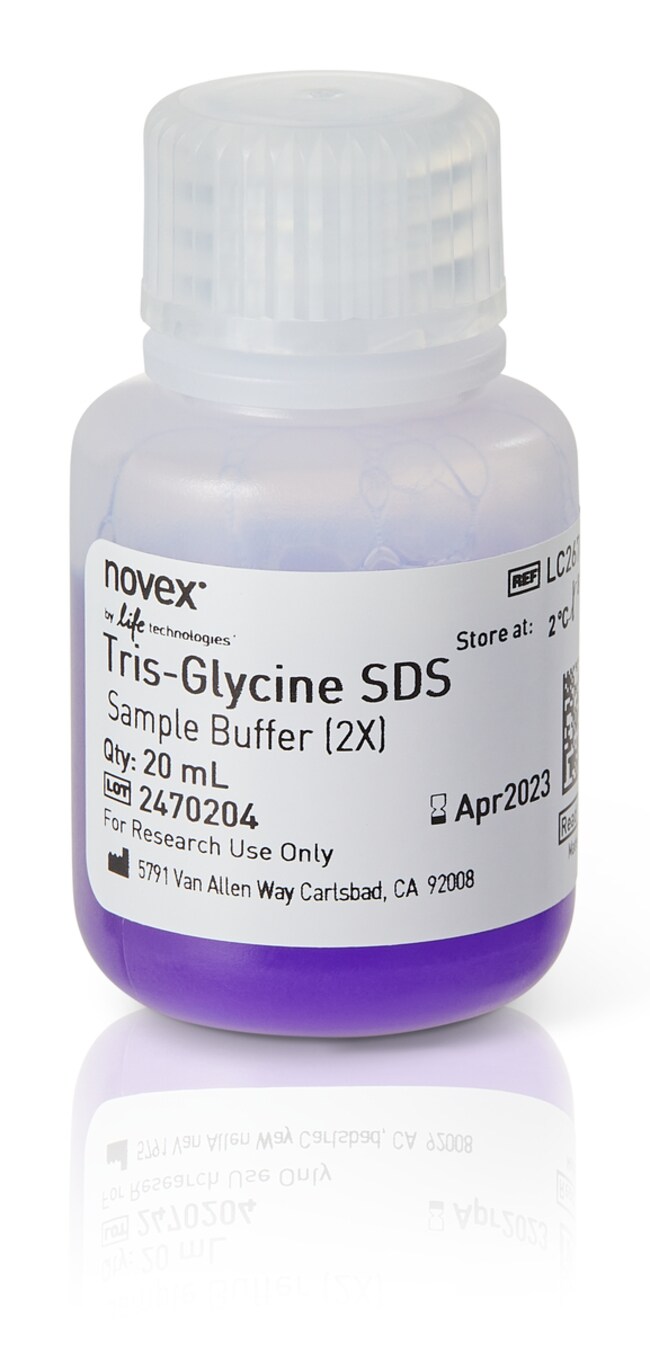Search Thermo Fisher Scientific
Novex™ Tris-Glycine SDS Sample Buffer (2X)
 Promotion
Promotion Promotion
Promotion| Catalog Number | Quantity |
|---|---|
LC2676 | 20 mL |
See all available buffers and reagents available for SDS-PAGE
To use: Heat the sample in a 1X dilution (reduced or non-reduced) at 85°C for 2–5 minutes for optimal results. Heating samples at 100°C in SDS-containing buffers results in proteolysis.
Store at 2°C to 8°C.
Customers who viewed this item also viewed
Documents & Downloads
Certificates
Safety Data Sheets
Frequently asked questions (FAQs)
The formulations of buffers for our precast protein gels can be found at this link: https://www.thermofisher.com/us/en/home/life-science/protein-biology/protein-gel-electrophoresis/protein-electrophoresis-buffers-reagents.html
Find additional tips, troubleshooting help, and resources within our Protein Electrophoresis and Western Blotting Support Center.
The Laemmli buffer or 2X SDS Buffer is composed of the following: 100 mM Tris HCl , pH 6.8, 200 mM dithiothreitol, 4% SDS, 0.2% bromophenol blue, 20% glycerol. 2X SDS gel loading buffer lacking dithiothreitol can be stored at room temperature. Dithiothreitol should then be added, just before use.
Find additional tips, troubleshooting help, and resources within our Protein Electrophoresis and Western Blotting Support Center.
If the Tricine gel is run with Tris-Glycine sample buffer, the bands will behave abnormally and resolve poorly. If the Tricine gel is accidentally run with Tris-Glycine running buffer, the gel will take longer to run and the resolution, especially for smaller proteins, will be worse than when the proteins are run on a Tris-Glycine gel with Tris-Glycine buffers. This is due to a combination of increase in stack area size (glycine is a slower ion than Tricine) and the higher ionic strength of the Tricine gel.
Find additional tips, troubleshooting help, and resources within our Protein Electrophoresis and Western Blotting Support Center.
SDS in a 4X sample buffer concentrate tends to precipitate from solution and to make the solution viscous and difficult to pipette. The LDS is much more soluble.
Find additional tips, troubleshooting help, and resources within our Protein Gel 1D Electrophoresis Support Center.
No, CTAB will not work with any of our gels except for the NuPAGE Tris-Acetate gels. To use CTAB, you would need to use a running buffer of 50 mM acetic acid and 50 mM beta-alanine in equal concentrations. You would also need to switch the electrodes. Since CTAB is a cationic detergent, this would establish conditions for running a basic protein towards the anode (into the gel).
Find additional tips, troubleshooting help, and resources within our Protein Electrophoresis and Western Blotting Support Center.


